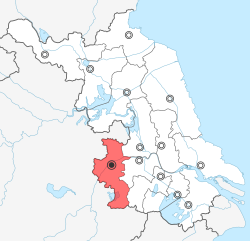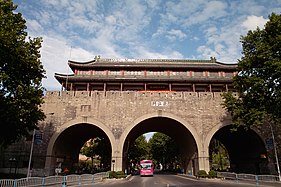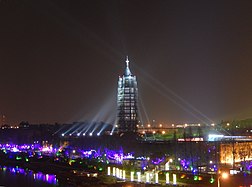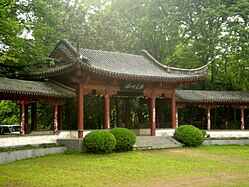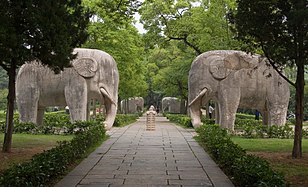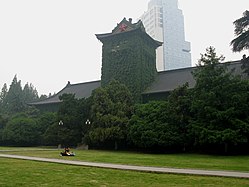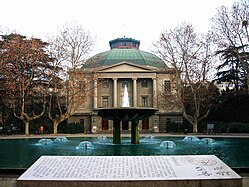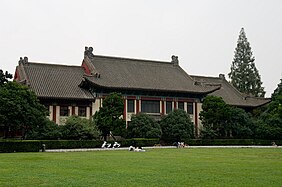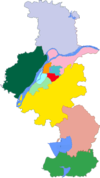|
Nanjing
Nanjing[b] is the capital of Jiangsu, a province in East China. The city, which is located in the southwestern corner of the province, has 11 districts, an administrative area of 6,600 km2 (2,500 sq mi), and as of 2021[update] a population of 9,423,400.[6] Situated in the Yangtze River Delta, Nanjing has a prominent place in Chinese history and culture, having served as the capital of various Chinese dynasties, kingdoms and republican governments dating from the 3rd century to 1949,[7] and has thus long been a major center of culture, education, research, politics, economy, transport networks and tourism, being the home to one of the world's largest inland ports. The city is also one of the fifteen sub-provincial cities in the People's Republic of China's administrative structure,[8] enjoying jurisdictional and economic autonomy only slightly less than that of a province.[9] It has also been awarded the title of 2008 Habitat Scroll of Honor of China, Special UN Habitat Scroll of Honor Award and National Civilized City.[10] Nanjing is also considered a Beta (global second-tier) city classification, together with Chongqing, Hangzhou and Tianjin by the Globalization and World Cities Research Network,[11] and ranked as one of the world's top 100 cities in the Global Financial Centres Index.[12] As of 2021, Nanjing has 68 institutions of higher learning,[13][14] including 13 double-first-class universities, ten 111-plan universities, eight 211 universities, and 97 academies.[15] Nanjing University, which has a long history, is among the world's top 20 universities ranked by the Nature Index.[16] The ratio of college students to the total population ranks No.1 among large cities nationwide. Nanjing has the fifth-largest scientific research output of any city in the world.[17] As of 2024, it has been ranked as the world's second most prolific scientific research center in earth and environmental sciences and the world's third most prolific scientific research center in chemistry and physical sciences, according to the Nature Index.[18][19][20][21] Nanjing, one of the nation's most important cities for over a thousand years, is recognized as one of the Four Great Ancient Capitals of China. It has been one of the world's largest cities, enjoying peace and prosperity despite various wars and disasters.[22][23][24][25] Nanjing served as the capital of Eastern Wu (229–280), one of the three major states in the Three Kingdoms period; the Eastern Jin and each of the Southern dynasties (Liu Song, Southern Qi, Liang and Chen), which successively ruled southern China from 317 to 589; the Southern Tang (937–75), one of the Ten Kingdoms; the Ming dynasty when, for the first time, all of China was ruled from the city (1368–1421);[26] and the Republic of China under the nationalist Kuomintang (1927–37, 1946–49) before its flight to Taiwan by Chiang Kai-Shek during the Chinese Civil War.[27] The city also served as the seat of the rebel Taiping Heavenly Kingdom (1853–64) and the Japanese puppet regime of Wang Jingwei (1940–45) during the Second Sino-Japanese War. It suffered many notable devastating atrocities in both conflicts, most notably the Nanjing Massacre from late 1937 to early 1938.[28] Nanjing became the capital city of Jiangsu province in 1952, after serving as a Direct-administered Municipality from 1949 to 1952 following the establishment of the People's Republic of China. It has many important heritage sites, including the Presidential Palace, Sun Yat-sen Mausoleum and Ming Xiaoling Mausoleum. Nanjing is famous for human historical landscapes, mountains and waters such as Fuzimiao, Ming Palace, Chaotian Palace, Porcelain Tower, Drum Tower, Stone City, City Wall, Qinhuai River, Xuanwu Lake and Purple Mountain. Key cultural facilities include Nanjing Library, Nanjing Museum and Jiangsu Art Museum.
NamesThe city has a number of other names, and some historical names are now used as names of districts of the city. The city was known as Yuecheng and Jinling or "Ginling" (金陵) from the Warring States Era. Jianye (建业; Chien-yeh), which means 'build an empire', was officially designated for the city during the Eastern Wu dynasty. The city first became a Chinese national capital as early as the Jin dynasty and was renamed Jiankang. Nanjing is also called Jincheng (金城, Golden City), derived from Jinling City. The name Nanjing, which means "southern capital", was officially designated for the city during the Ming dynasty, about six hundred years later.[c] In English, the spelling Nanking was traditional until pinyin, developed in the 1950s and internationally adopted in the 1980s, standardized the spelling as "Nanjing". During the Qing dynasty, the city was called Jiangning (江寧; Kiang-ning), whose first character jiang (Chinese: 江; pinyin: jiāng; lit. 'river', i.e. the Yangtze) is the former part of the name Jiangsu and second character ning (寧, simplified form 宁; 'peace') is the shortened name of Nanjing. When it was the capital of the Republic of China (1912–49), jing (京; 'capital') was adopted as the abbreviation of Nanjing. History
Early history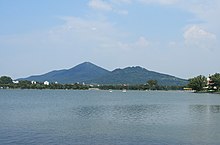 Archaeological discovery shows that the so-called "Nanjing Man" lived more than 500,000 years ago. Zun, a kind of wine vessel, were found to exist in Beiyinyangying culture of Nanjing about 5000 years ago.[29] About 7000 years ago, there was an agricultural civilization in the area that is now Qixia. In the Jiangning district, ruins of primitive villages from the Neolithic Age were discovered.[when?][citation needed] About 4000 years ago, dense Bronze Age primitive settlements appeared in the Qinhuai River Basin, labeled as the Hushu culture. The earliest cities in Nanjing were formed around these settlements. Due to the volume of archeological finds in the area related to the Taowu and Hushu cultures, many historians, anthropologists, and archeologists frequent the Nanjing area.[30] Hushu culture developed into Wu culture under the influence of the Shang and Zhou, who encroached from Central Plains. From the traditions, Taibo of Zhou came to Jiangnan and established the state of Wu during the 12th century BC. In 571 BC, the State of Chu established Tangyi in Liuhe. This is the oldest extant administrative establishment in Nanjing; as of 2025 it has a history 2596 years long. In 541, Wu built Laizhu Town in Gaochun—because of its strong city, it was also called Gucheng. Fuchai, King of the State of Wu, founded a fort named Yecheng in today's Nanjing area in 495 BC.[31] Wu was conquered by the State of Yue in 473 BC, and the city was rebuilt at the mouth of the Qinhuai River in the following year. Later it was called Yuecheng (越城) on the outskirts of the present-day Zhonghua Gate, which was the beginning of the construction of the main city of Nanjing. In 333 BC, Chu defeated Yue and built Jinling Yi (金陵邑) on in the western part of Nanjing.[32] It was the earliest administrative construction in the main city of Nanjing. The name of Jinling comes from this. In 210 BC, the First Emperor of Qin visited the east and changed Jinling City to Moling (秣陵). The area was successively part of Kuaiji, Zhang and Danyang prefectures in Qin and Han dynasty, and part of Yangzhou region which was established as the nation's 13 supervisory and administrative regions in the 5th year of Yuanfeng in Han dynasty (106 BC).[citation needed] Nanjing was later the capital city of Danyang Prefecture, and had been the capital city of Yangzhou for about 400 years from late Han to early Tang.[citation needed] Capital of the Six Dynasties Six Dynasties is a collective term for six Chinese dynasties mentioned above which all maintained national capitals at Jiankang. The six dynasties were: Eastern Wu (222–280), Eastern Jin dynasty (317–420) and four southern dynasties (420–589). At the end of the Eastern Han dynasty, the warlord Sun Quan, who ruled Jiangdong, moved his ruling office to Moling in 211 AD. The following year, he built the Stone City at the site of Jinling Yi, and renamed Moling to Jianye. Jianye later became the capital of the Eastern Wu dynasty during the Three Kingdoms period, after Sun Quan proclaimed himself emperor in 229, opening Nanjing's history as a state capital.[26] By the time Wu was conquered by the Western Jin dynasty in 280, Jianye and its neighboring areas had been well cultivated, developing into one of the commercial, cultural and political centers of China.[25] Not long after the unification of China, the Western Jin collapsed under the weight of civil wars by eight princes and rebellions from the so-called "Five Barbarians" in the north. Jianye, renamed to Jiankang in 313 to avoid Emperor Min of Jin's taboo name, was safely isolated from the chaos and became a popular refuge for the northern nobles and wealthy families. In 318, the ruling prince in Jiankang, Sima Rui proclaimed himself the new emperor and reestablished the dynasty as the Eastern Jin dynasty.[34] This marked the first time a Chinese dynastic capital was moved from the north to southern China, as the north came under the rule of the Sixteen Kingdoms.  Jiankang was the centre of administration in the south for more than two and a half centuries, even as China entered the Northern and Southern dynasties period. After the Eastern Jin fell in 420, it continued to serve as the capital for the Southern dynasties of Liu Song, Southern Qi, Liang and Chen. During this time, Jiankang was the international hub of East Asia.[35] Based on historical documents, the city had 280,000 registered households.[36] Assuming an average Nanjing household consisted of about 5.1 people, the city had more than 1.4 million residents.[34] A number of sculptural ensembles of that era, erected at the tombs of royals and other dignitaries, have survived (in various degrees of preservation) in Nanjing's northeastern and eastern suburbs, primarily in Qixia and Jiangning District.[37] Possibly the best preserved of them is the ensemble of the Tomb of Xiao Xiu (475–518), a brother of Emperor Wu of Liang.[38][39]
Destruction and revival
— About the former opulent capital Jinling (present-day Nanjing) in the poem Climbing Phoenix Terrace at Jinling by Li Bai of the Tang dynasty[40]
The period of division ended when the Sui dynasty reunified China and almost destroyed the entire city, turning it into a small town. The city was razed after the Sui took it over. It was renamed Shengzhou (昇州) in the Tang dynasty and resuscitated during the late Tang.[41] It was chosen as the capital and called Jinling (金陵) during the Southern Tang (937–976), which succeeded the state of Yang Wu.[42] It was renamed Jiangning (江寧, "Pacified Area of the Yangtze") in the Northern Song and renamed Jiankang in the Southern Song. Jiankang's textile industry burgeoned and thrived during the Song despite the constant threat of foreign invasions from the north by the Jurchen-led Jin dynasty. The court of Da Chu, a short-lived puppet state established by the Jurchens, and the court of Song were once in the city.[43][44][45] The Southern Song were eventually destroyed by the Mongols; during their rule as the Yuan dynasty, the city's status as a hub of the textile industry was further consolidated.[46] According to Odoric of Pordenone, Chilenfu (Nanjing) had 360 stone bridges, which were finer than anywhere else in the world. It was well populated and had a large craft industry.[47]
Southern capital of the Ming dynasty  After Zhu Yuanzhang (known from his era as the Hongwu Emperor) overthrew the Yuan and established the Ming dynasty, he renamed the city Yingtian (應天), rebuilt it, and made it the dynastic capital in 1368, overseeing the surrounding areas under a special administration. The Hongwu Emperor constructed a 48 km (30 mi) long city wall around Yingtian, as well as a new Ming Palace complex, and government halls.[48] It took 200,000 laborers 21 years to finish the wall, which was intended to defend the city and its surrounding region from coastal pirates.[49] The present-day City Wall of Nanjing was mainly built during that time and today it remains in good condition and has been well preserved.[50] It is among the longest surviving city walls in China.[51] The Jianwen Emperor ruled from Yingtian from 1398 to 1402. It is believed that Nanjing was the largest city in the world from 1358 to 1425 with a population of 487,000 in 1400.[52] Having usurped power from his nephew and uncertain of the loyalty of the region's officials, the Yongle Emperor relocated the capital in 1421 to Beijing, where he had long served as the regional governor as the Prince of Yan. Because the new status of Yingtian was included in the Hongwu Emperor's "ancestral injunctions" for his dynasty, however, the Yongle Emperor was obliged to preserve its special status, at least in name. The "northern capital" came to be known as Beijing and the 'southern capital' as Nanjing (南京). Both controlled territories "directly administered" by the emperor and his staff, Beizhili in the north and Nanzhili in the south.  The Hongxi Emperor wanted to restore Nanjing as the sole imperial capital and undertook preparations to do so.[53] On February 24, 1425, he appointed Admiral Zheng He as the defender of Nanjing and ordered him to continue his command over the Ming treasure fleet for the city's defense.[53] Zheng He governed the city with three eunuchs for internal matters and two military noblemen for external matters, awaiting the Hongxi Emperor's return along with the military establishment from the north.[53] The emperor died on May 29, 1425, before this could have taken place.[53][54] The succeeding Xuande Emperor preferred to remain in Beijing, leaving it the primary and de facto capital[54] and Nanjing as permanent secondary or reserve capital.[55] Owing to the continuing importance of the ancestral injunctions, however, Nanjing was designated in official documents as the actual capital and Beijing as a temporary capital from 1425 to 1441.[56] In 1441, the Yingzong Emperor ordered the "provisional" (行在) prefix removed from Beijing's government seals and further ordered that the southern imperial administration would henceforth be required to prefix "Nanjing" to their own seals to distinguish them. Besides the city wall, other Ming-era structures in the city included the famous Ming Xiaoling Mausoleum and Porcelain Tower, although the latter was destroyed by the Taipings in the 19th century either to prevent a hostile faction from using it to observe and shell the city[57] or from superstitious fear of its geomantic properties.[58] A monument to the huge human cost of some of the gigantic construction projects of the early Ming dynasty is the Yangshan Quarry (located some 15–20 km (9–12 mi) east of the walled city and Ming Xiaoling mausoleum), where a gigantic stele, cut on the orders of the Yongle Emperor, lies abandoned.[59] As the center of the empire, early-Ming Nanjing had worldwide connections. It was home of the admiral Zheng He, who went to sail the Pacific and Indian Oceans, and it was visited by foreign dignitaries, such as a king from Borneo (渤泥; Bóní), who died during his visit to China in 1408. The Tomb of the King of Boni, with a spirit way and a tortoise stele, was discovered in Yuhuatai District (south of the walled city) in 1958, and has been restored.[60]
Capital of the Southern MingOver two centuries after the removal of the capital to Beijing, Nanjing was destined to become the capital of a Ming emperor one more time. After the fall of Beijing to Li Zicheng's rebel forces and then to the Manchu-led Qing dynasty in the spring of 1644, the Ming prince Zhu Yousong was enthroned in Nanjing in June 1644 as the Hongguang Emperor.[61][62] His short reign was described by later historians as the first reign of the so-called Southern Ming dynasty.[63][d] Zhu Yousong, however, fared a lot worse than his ancestor Zhu Yuanzhang three centuries earlier. Beset by factional conflicts, his regime could not offer effective resistance to Qing forces, when the Qing army, led by the Manchu prince Dodo approached Jiangnan the next spring.[64] Days after Yangzhou fell to the Manchus in late May 1645, the Hongguang Emperor fled Nanjing, and the imperial Ming Palace was looted by local residents.[65] On June 6, Dodo's troops approached Nanjing, and the commander of the city's garrison, Zhao the Earl of Xincheng, promptly surrendered the city to them.[66][67] The Manchus soon ordered all male residents of the city to shave their heads in the Manchu queue way.[68][69][70] They requisitioned a large section of the city for the bannermen's cantonment, and occupied the former imperial Ming Palace, but otherwise the city was spared the mass murders and destruction that befell Yangzhou.[71]  Despite capturing many counties in his initial attack due to surprise and having the initiative, Koxinga announced the final battle in Nanjing in 1659 ahead of time giving plenty of time for the Qing to prepare because he wanted a decisive, single grand showdown as his father successfully did against the Dutch at the Battle of Liaoluo Bay, throwing away the surprise and initiative which led to its failure. Koxinga's attack on Qing held Nanjing which would interrupt the supply route of the Grand Canal leading to possible starvation in Beijing caused such fear that the Manchus (Tartares) considered returning to Manchuria (Tartary) and abandoning China according to a 1671 account by a French missionary.[72] The commoners and officials in Beijing and Nanjing were waiting to support whichever side won. An official from Qing Beijing sent letters to family and another official in Nanjing, telling them all communication and news from Nanjing to Beijing had been cut off, that the Qing were considering abandoning Beijing and moving their capital far away to a remote location for safety since Koxinga's iron troops were rumored to be invincible. Koxinga's forces intercepted these letters and after reading them Koxinga may have started to regret his deliberate delays allowing the Qing to prepare for a final massive battle instead of swiftly attacking Nanjing.[73] Koxinga's Ming loyalists fought against a majority Han Chinese Bannermen Qing army when attacking Nanjing. The siege lasted almost three weeks. Koxinga's forces were unable to maintain a complete encirclement, which enabled the city to obtain supplies and even reinforcements—though cavalry attacks by the city's forces were successful even before reinforcements arrived. Koxinga's forces were defeated and "slipped back" to the ships which had brought them.[74]
Qing dynasty and Taiping Rebellion Under the Qing dynasty from 1645 to 1911, Nanjing returned to its previous name Jiangning.[e] At first, it continued to administer the territory of Nanzhili under the name Jiangnan ("Area South of the Yangtze") but this administration was soon broken up into "Right" and "Left" governments based in Suzhou and Jiangning respectively. After a series of reorganizations, at some point under the Qianlong Emperor, Jiangnan was fully divided into the present provinces of Anhui and Jiangsu. Separately, however, these provinces were reunited under the supervision of a new Viceroy of Liangjiang after 1723, whose seat was based in Jiangning.[75] It was the site of a Qing Army garrison.[76] It had been visited by the Kangxi and Qianlong emperors a number of times on their tours of the southern provinces. The 1842 Treaty of Nanking, which put an end to the First Opium War, was signed in the city harbor on Royal Navy warships. As the capital of the brief-lived rebel Taiping Heavenly Kingdom in the mid-19th century, Nanjing was known as Tianjing (天京; 'Heavenly Capital" or "Capital of Heaven'). The rebellion destroyed most of the former Ming imperial buildings in the city, including the Porcelain Tower, considered up to that time as one of the wonders of the world. Both the Qing viceroy and the Taiping king resided in buildings that would later be known as the Presidential Palace. When Qing forces led by Zeng Guofan retook the city in 1864, a massive slaughter occurred in the city with over 100,000 estimated to have committed suicide or fought to the death.[77] Since the Taiping Rebellion began, Qing forces allowed no rebels speaking its dialect to surrender.[78] This was one of two historically significant instances of systematic civilian massacres in Nanjing, the other one was the Houjing Disturbance of the 6th century.[79] The New York Methodist Mission Society's superintendent Virgil Hart arrived in Nanjing in 1881. After some time, he succeeded in buying land near the city's Southern Gate and Confucian Temple to build the city's first Methodist church, Western hospital and boys' school. The hospital would later be unified with the Drum Tower Hospital and the boys' school would be expanded by later missionaries to become the University of Nanking and Medical School. The old mission property became the No. 13 Middle School, the oldest continually-used school grounds in the city.[80][page needed] Capital of the Republic and Nanjing Massacre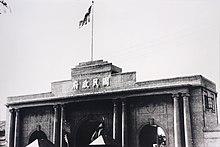 The Xinhai Revolution led to the founding of the Republic of China in January 1912 with Sun Yat-sen as the first provisional president and Nanjing was selected as its new capital.[citation needed] However, the Qing Empire controlled large regions to the north, so the revolutionaries asked Yuan Shikai to replace Sun as president in exchange for the abdication of Puyi, the last emperor. Yuan demanded the capital be moved to Beijing (closer to his power base).[citation needed] In 1927, the Kuomintang (KMT; Nationalist Party) under Generalissimo Chiang Kai-shek again established Nanjing as the capital of the Republic of China, and this became internationally recognized once KMT forces took Beijing in 1928. The following decade is known as the Nanjing decade. During this decade, Nanjing was of symbolic and strategic importance. The Ming dynasty had made Nanjing a capital, the republic had been established there in 1912, and Sun Yat-sen's provisional government had been there.[citation needed] Sun's body was brought and placed in a grand mausoleum to cement Chiang's legitimacy. Chiang was born in the neighboring province of Zhejiang and the general area had strong popular support for him.[citation needed]  In 1927, the Nationalist government proposed a comprehensive planning proposal, the Capital Plan (首都計劃), to reconstruct the war-torn city of Nanjing into a modern capital.[citation needed] It was a decade of extraordinary growth with an enormous amount of construction. A lot of government buildings, residential houses, and modern public infrastructures were built. During this boom, Nanjing reputedly became one of the most modern cities in China.[citation needed] In 1937, the Empire of Japan started a full-scale invasion of China after invading Manchuria in 1931, beginning the Second Sino-Japanese War (often considered a theater of World War II).[81] Their troops occupied Nanjing in December and carried out the systematic and brutal Nanjing Massacre (the "Rape of Nanjing").[82] The total death toll, including estimates made by the International Military Tribunal for the Far East and the Nanjing War Crimes Tribunal after the atomic bombings, was between 300,000 and 350,000.[83] The city itself was also severely damaged during the massacre.[82] The Nanjing Massacre Memorial Hall was built in 1985 to commemorate this event. A few days before the fall of the city, the National Government of China was relocated to the southwestern city Chongqing and resumed Chinese resistance. In 1940, a Japanese-collaborationist government known as the "Nanjing Regime" or "Reorganized National Government of China" led by Wang Jingwei was established in Nanjing as a rival to Chiang Kai-shek's government in Chongqing.[84] In 1946, after the Surrender of Japan, the KMT relocated its central government back to Nanjing. 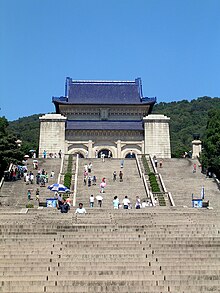 Chinese Civil War and People's RepublicIn April 1949, Communist forces crossed the Yangtze River and the Communist People's Liberation Army (PLA) captured Nanjing.[85] The KMT government retreated to Canton (Guangzhou) until October 15, Chongqing until November 25, and then Chengdu before retreating to the island of Taiwan on December 10 where Taipei was proclaimed the temporary capital of the Republic of China. By late 1949, the PLA was pursuing remnants of KMT forces southwards in southern China, and only Tibet and Hainan Island were left. After the establishment of the People's Republic of China in October 1949, Nanjing was initially a province-level municipality, but it was soon merged into Jiangsu and again became the provincial capital by replacing Zhenjiang which was transferred in 1928, and retains that status to this day. Geography   Nanjing, with a total land area of 6,598 km2 (2,548 sq mi), is situated in the heartland of the drainage area of the lower reaches of the Yangtze River, and in the Yangtze River Delta, one of the largest economic zones of China. The Yangtze River flows past the west side and then the north side of Nanjing City, while the Ningzheng Ridge surrounds the north, east and south sides of the city. The city is 650 km (400 mi) southeast of Luoyang, 900 km (560 mi) south-southeast of Beijing, 270 km (170 mi) west-northwest of Shanghai, and 1,200 km (750 mi) east-northeast of Chongqing. The Yangtze flows downstream from Jiujiang, Jiangxi, through Anhui and Jiangsu to the East China Sea. The northern part of the lower Yangtze drainage basin is the Huai River basin and the southern part is the Zhe River basin; they are connected by the Grand Canal east of Nanjing. The area around Nanjing is called Xiajiang (下江, Downstream River) region, with Jianghuai dominant in the northern part and Jiangzhe dominant in the southern part.[f] The region is also well known as Dongnan (东南, South East, the Southeast) and Jiangnan (江南, and River South, South of Yangtze).[g] Nanjing borders Yangzhou to the northeast; Zhenjiang to the east; and Changzhou to the southeast. On its western boundary is Anhui, where Nanjing borders five prefecture-level cities: Chuzhou to the northwest, Wuhu, Chaohu and Ma'anshan to the west and Xuancheng to the southwest.[86] Climate and environment
Nanjing has a humid subtropical climate (Köppen Cfa) and is influenced by the East Asian monsoon. The four seasons are distinct, with damp conditions seen throughout the year, very hot and muggy summers, cold, damp winters, and in between, spring and autumn are of reasonable length. Along with Chongqing and Wuhan, Nanjing is traditionally referred to as one of the "Three Furnaces" along the Yangtze River for the perennially high temperatures in the summertime.[88] However, the time from mid-June to the end of July is the plum blossom blooming season in which the meiyu (rainy season of East Asia; literally "plum rain") occurs, during which the city experiences a period of mild rain as well as dampness. The northeast wind prevails in winter. The average temperature in January is 3.1 °C (37.6 °F), and the extreme daily minimum temperature is −14.0 °C (6.8 °F), which occurred on January 6, 1955. The southeast wind prevails in summer, with an average temperature of 28.4 °C (83.1 °F) in July and an extreme daily maximum temperature of 43.0 °C (109.4 °F), which occurred on July 13, 1934. The number of precipitation days greater than 0.1 mm was 113 days, and the extreme maximum annual precipitation days were 160 days in 1957. The average annual precipitation is 1,144 mm (45.0 in). Typhoons are uncommon but possible in the late stages of summer and early part of autumn. The annual mean temperature is around 16.4 °C (61.5 °F), with the monthly 24-hour average temperature ranging from 3.1 °C (37.6 °F) in January to 28.4 °C (83.1 °F) in July. Extremes since 1951 have ranged from −14.0 °C (7 °F) on January 6, 1955, to 40.7 °C (105 °F) on August 22, 1959.[89][90][91] On average precipitation falls 113 days out of the year, and the average annual rainfall is 1,144 mm (45 in). With monthly percent possible sunshine ranging from 37 percent in June to 48 percent in August and October, the city receives 1,932 hours of bright sunshine annually. Nanjing is endowed with rich natural resources, which include more than 40 kinds of minerals. Among them, iron and sulfur reserves make up 40 percent of those of Jiangsu province. Its reserves of strontium rank first in East Asia and the Southeast Asia region. Nanjing also possesses abundant water resources, both from the Yangtze River and groundwater. In addition, it has several natural hot springs such as Tangshan Hot Spring in Jiangning and Tangquan Hot Spring in Pukou. Xuanwu Lake and Mochou Lake are located in the center of the city and are easily accessible to the public, while Purple Mountain is covered with deciduous and coniferous forests preserving various historical and cultural sites. Meanwhile, a Yangtze River deep-water channel is under construction to enable Nanjing to handle the navigation of 50,000 DWT vessels from the East China Sea.[92]
CityscapeEnvironmental issues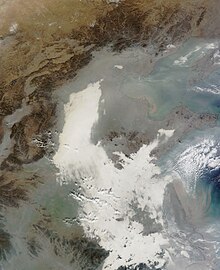 A dense wave of smog began in the central and east parts of China on December 2, 2013, across a distance of around 1,200 km (750 mi),[95] including Tianjin, Hebei, Shandong, Jiangsu, Anhui, Shanghai and Zhejiang. A lack of cold air flow, combined with slow-moving air masses carrying industrial emissions, collected airborne pollutants to form a thick layer of smog over the region.[96] The heavy smog heavily polluted central and southern Jiangsu Province, especially in and around Nanjing,[97] with its AQI pollution Index at "severely polluted" for five straight days and "heavily polluted" for nine.[98] Officials blamed the dense pollution on lack of wind, automobile exhaust emissions under low air pressure, and coal-powered district heating system in north China.[99] Prevailing winds blew low-hanging air masses of factory emissions (mostly SO2) towards China's east coast.[100] SoilThere are mainly two types of soil in Nanjing: zonal soil and cultivated soil. The zonal soil is yellow-brown soil in the northern and central areas of Nanjing, and red soil in the southern part of the border with Anhui. The cultivated soil formed by human-made farming is mainly paddy soil, and there are some yellow Gang soil and vegetable garden soil. The distribution of soil presents a certain law with the undulation of topography and hydrological conditions, which can be divided into three categories: low mountain and hilly area, hilly area and plain area. According to the second national soil survey from 1980 to 1987, the soil in Nanjing is divided into 7 soil types, 13 subtypes, 30 soil genera and 66 soil species, with a total area of 416,300 hectares. Water Nanjing is located at the lower reaches of the Yangtze River. The Yangtze River runs diagonally across the city from southwest to northeast. It is about 93 kilometers long and more than 300 kilometers away from the sea entrance. The Qinhuai River rushes from south to north, passes through the main urban area, and joins the Yangtze River. It is known as the mother river of Nanjing. Xuanwu Lake and Mochou Lake are like two pearls embedded in the main city. The water area of the city now accounts for about 11%. The river and lake water system mainly belongs to the Yangtze River system, and only the rivers that flow into Gaoyou Lake and Baoying Lake in the northern part of Liuhe District belong to the Huai River system. The Yangtze River system includes the Qinhuai River system in the south of the Yangtze River, the Chuhe River system in the north of the Yangtze River, the riverside system formed by small rivers that flow into the river on both sides of the river, the two lakes system composed of Shijiu Lake and Gucheng Lake, and the West Taihu Lake system in the east of Gaochun. The groundwater resources are abundant and the water quality is excellent, and the Pukou Pearl Spring is particularly famous. Jiangning Tangshan and Pukou Tangquan are hot spring areas with a long history. The Port of Nanjing is the largest inland port in China, with annual cargo tonnage reached 191,970,000 t in 2012.[101] The port area is 98 km (61 mi) in length and has 64 berths including 16 berths for ships with a tonnage of more than 10,000.[102] Nanjing is also the biggest container port along the Yangtze River; in March 2004, the one million container-capacity base, Longtan Containers Port Area opened, further consolidating Nanjing as the leading port in the region. As of 2010[update], it operated six public ports and three industrial ports.[103] The Yangtze River's 12.5-meter-deep waterway enables 50,000-ton-class ocean ships directly arrive at the Nanjing Port, and the ocean ships with the capacities of 100,000 tons or above can also reach the port after load reduction in the Yangtze River's high-tide period.[104] CSC Jinling has a large shipyard.[105] Animal and plant resourcesNanjing is one of the regions with abundant plant resources and a wide variety of plants in China. The vegetation types are complex, including 7 types of natural vegetation including coniferous forest, deciduous broad-leaved forest, mixed deciduous and evergreen broad-leaved forest, bamboo forest, shrub, grass and aquatic vegetation. Cultivated vegetation includes field crops, vegetable crops, and economic forests, orchards and green belts. Plant species, there are 1061 species of vascular plants, accounting for 64.7% of the total in Jiangsu Province. Seven species such as Sphaerocarpus sinensis, Chinese Allium chinense, Ming Codonopsis, and Pterocarpus sinensis are national key protected rare and endangered plants. The city's forest coverage rate is 27.1%. Among wild animals, there are 795 species of insects belonging to 125 families of 11 orders. There are 99 species of fish belonging to 22 families and 12 orders. There are 327 species of terrestrial wild vertebrates, belonging to 29 orders and 90 families. 243 species of birds belong to 56 families of 17 orders. 47 species of mammals belong to 8 orders and 22 families. Among all animal species, 9 species of wild animals under national first-level protection, such as the Oriental White Crane and White Shoulder Eagle, 65 species of wild animals under the second-level protection, such as the little swan, Chinese tiger and swallowtail, and finless porpoise, and 125 key protected animals in Jiangsu Province Species, 35 species of endangered animals. Yangtze River crossings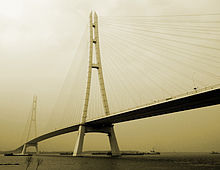 In the 1960s, the first Nanjing Yangtze River Bridge was completed, and served as the only bridge crossing over the Lower Yangtze in eastern China at that time. The bridge was a source of pride and an important symbol of modern China, having been built and designed by the Chinese themselves following failed surveys by other nations and the reliance on and then rejection of Soviet expertise. Begun in 1960 and opened to traffic in 1968, the bridge is a two-tiered road and rail design spanning 4,600 m (15,100 ft) on the upper deck, with approximately 1,580 m (5,180 ft) spanning the river itself. Since then four more bridges and four tunnels have been built. Going in the downstream direction, the Yangtze crossings in Nanjing are: Dashengguan Bridge, Third Bridge, Fifth Nanjing Yangtze River Bridge, Nanjing Yangtze River Tunnel (南京长江隧道), Line 10 Metro Tunnel, Nanjing Yangtze Tunnel (南京扬子江隧道), First Bridge, Yanziji Yangtze River Tunnel,[106] Nanjing Baguazhou Yangtze River Bridge and Nanjing Qixiashan Yangtze River Bridge. Mineral resourcesNanjing is rich in mineral resources. The discovered minerals mainly include 41 types of iron, copper, lead, zinc, strontium, ferrosulfide, dolomite, limestone, gypsum, and clay, among which 23 are of proven reserves and 20 are of industrial mining value. There are more than 10 kinds being mined. The quality and reserves of strontium ore (celestite) rank first in the country. The reserves of copper and lead-zinc ore account for more than 90% of the province, iron ore accounts for 89% of the province, and limestone, dolomite, and attapulgite clay mines are in the whole province. Province occupies an important position. Nanjing's minerals are mainly concentrated in 4 metallogenic belts, namely Jiangpu-Liuhe iron and copper metallogenic belt, Ningzhen iron, copper, and sulfur polymetallic metallogenic belt, Ningwu iron, copper. Government At present, the full name of the government of Nanjing is "People's Government of Nanjing City" and the city is under the one-party rule of the CPC, with the CPC Nanjing Committee Secretary as the de facto governor of the city and the mayor as the executive head of the government working under the secretary. Administrative divisionsThe sub-provincial city of Nanjing is divided into 11 districts.[107]
Demographics
At the time of the 2010 census, the total population of the City of Nanjing was 8.005 million. The OECD estimated the encompassing metropolitan area at the time as 11.7 million.[112] Official statistics in 2011 estimated the city's population to be 8.11 million. The birth rate was 8.86 percent and the death rate was 6.88 percent. The urban area had a population of 6.47 million people. The sex ratio of the city population was 107.31 males to 100 females.[113][114] As in most of eastern China, the official ethnic makeup of Nanjing is predominantly Han nationality (98.56 percent), with 50 other official ethnic groups. In 1999, 77,394 residents belonged to officially defined minorities, among which the vast majority (64,832) were Hui, contributing 83.76 percent to the minority population. The second and third largest minority groups were Manchu (2,311) and Zhuang (533). Most of the minority nationalities resided in Jianye District, comprising 9.13 percent of the district's population.[115] LanguagesNanjing Mandarin is spoken in most parts of Nanjing, while Wu Chinese is spoken in most of the Gaochun District and the southern part of Lishui District. Nanjing dialect has been the official language of China for a long time in history. Jinling Yayan was established as the standard pronunciation of Chinese as an orthodox traditional Chinese dialect in the ancient Central Plains. In July 2017, the Ministry of Education and the National Language Commission held a press conference, and the penetration rate of Mandarin has reached 73%. ReligionNanjing has four major religions: Buddhism, Taoism, Christianity, and Islam. Nanjing is one of the earliest areas in China to spread Buddhist culture. The "480 Temples in the Southern Dynasties" has become the center of Chinese Buddhist culture and the ancestral home of the Sanlunzong, Niutouzong, Fayanzong, and other Buddhist sects. Nanjing is also the place for the revival of modern Chinese Buddhist culture. The Jinling Carved Scriptures integrates Buddhist publishing, dissemination, and research. It is still the world's unparalleled Chinese Buddhist scripture publishing and circulation center. The engraving and printing skills are included in the world's intangible cultural heritage of humanity. Ancient famous temples such as Jianchu Temple, Qixia Temple, Waguan Temple, Qingliang Temple, Jiming Temple, Dabaoen Temple, etc. were revived. Nanjing Taoism has a long history and occupies an important position in the history of Chinese Taoism.[citation needed] The spread of Catholicism in Nanjing began more than 400 years ago and was started by the scientist and missionary Matteo Ricci.[citation needed] The Shigu Road Catholic Church is the cathedral of the Catholic Diocese of Nanjing. The Nanjing Diocese with Nanjing as its center covers a vast area. As one of the national centers of Christianity in China, Nanjing has two seminaries, Jinling Theological Seminary and Jiangsu Theological Seminary. The Christian social service organization, Amity Foundation and the world's largest Bible printing company, Amity Printing Company are both in Nanjing. Nanjing is the birthplace of the Islamic "Renaissance" and has an important influence on the development of Chinese Islamic culture.[citation needed] Economy  The current economy of the city, is dominated by the service industries, accounting for about 60 percent of the GDP of the city, and financial industry, culture industry and tourism industry are the top three. Industries of information technology, energy saving and environmental protection, new energy, smart power grid and intelligent equipment manufacturing have become the pillar of the industries.[116] Big civilian-run enterprise include Suning Commerce, Yurun, Sanpower, Fuzhong, Hiteker, 5stars, Jinpu, Tiandi, CTTQ Pharmaceutical, Nanjing Iron and Steel Company and Simcere Pharmaceutical. Big state-owned firms include Panda Electronics, Yangzi Petrochemical, Jinling Petrochemical, Nanjing Chemical, Jincheng Motors, Jinling Pharmaceutical, Chenguang and NARI. The city has also attracted foreign investments. Multinational firms such as Siemens, Ericsson, Volkswagen, Iveco, A.O. Smith, and Sharp have established their offices, and a number of multinationals such as Ford, IBM, Lucent, Samsung and SAP have established research center here. Many China-based leading firms such as Huawei, ZTE and Lenovo have key R&D institutes in the city. Nanjing is an industrial technology research and development hub, hosting many R&D centers and institutions, especially in areas of electronics technology, information technology, computer software, biotechnology and pharmaceutical technology and new material technology. In recent years, Nanjing has been developing its economy, commerce, industry, as well as city construction. In 2013 the city's GDP was RMB 801 billion (3rd in Jiangsu), and GDP per capita (current price) was RMB 98,174(US$16041), an 11 percent increase from 2012. The average urban resident's disposable income was RMB 36,200, while the average rural resident's net income was RMB 14,513. The registered urban unemployment rate was 3.02 percent, lower than the national average (4.3 percent). Nanjing's Gross Domestic Product ranked 12th in 2013 in China, and its overall competence ranked 6th in mainland and 8th including Taiwan and Hong Kong in 2009.[117] In 2004, Nanjing ranked sixth in China's Economic Center Positioning Index, after Beijing, Shanghai, Guangzhou, Shenzhen, and Tianjin. In 2008, the Headquarters Economy Development Capacity ranked the city fifth in China, behind Beijing, Shanghai, Guangzhou, and Shenzhen. In 2014 China's regional central cities (excluding Beijing and Shanghai) competitiveness evaluation, Nanjing was second only to Shenzhen and Guangzhou. In 2015, Nanjing ranked fifth in China's investment attractive cities, closely following Beijing, Shanghai, Guangzhou, and Shenzhen. In August 2020, Nanjing ranked among China's top ten GDP in the first half of the year. In 2019, Nanjing's GDP was 1403,015 billion yuan, ranking 11th in the country, an increase of 7.8% over the previous year. The per capita GDP is 152,886 yuan, ranking second in China's municipalities, sub-provincial cities and provincial capitals, second only to Shenzhen, and the provincial capital ranking first. In 2021, Nanjing's GDP reached 1,6355.32 billion yuan. Primary industryNanjing is one of China's important agricultural and commercial grain bases. The main cash crops are rice, cotton, silkworm cocoons, hemp, tea, bamboo, fruits, medicinal materials, etc. Due to the fertile water quality on both sides of the Yangtze River, it is also one of China's important freshwater fishery bases. In 2019, the total output value of Nanjing's agriculture, forestry, animal husbandry, and fishery was 47.250 billion yuan, an increase of 4.8% over the previous year. Among them, the agricultural output value was 24.077 billion yuan, the forestry output value was 2.017 billion yuan, the animal husbandry output value was 2.435 billion yuan, the fishery output value was 15.389 billion yuan, and the agricultural, forestry, animal husbandry and fishery service industry output value was 3.333 billion yuan. Secondary industryIn 2019, Nanjing's total industrial added value was 421.577 billion yuan, an increase of 6.9%. The added value of industrial enterprises above the designated size was 309.226 billion yuan, an increase of 7.0%. Among the industries above designated size, the added value of state-owned and state-holding enterprises fell by 0.2%, private enterprises increased by 20.3%, and foreign companies, Hong Kong, Macao, and Taiwan enterprises increased by 7.0%. Large and medium-sized enterprises increased by 3.9%, and small and micro enterprises increased by 18.2%. Among the 37 major industries in the system, 22 industries have achieved growth in added value. Among the top ten industries ranked by cumulative value-added, six industries including electronics, electrical machinery, steel, medicine, general equipment, and non-metal products increased by 20.2%, Tertiary industryNanjing is an important regional financial and business center positioned by the National Development and Reform Commission. The financial industry is an important strategic pillar industry in Nanjing. The total financial volume and financial resources account for 25% of Jiangsu Province, and in the Financial Center index, the city ranks sixth in the country. In the 2018 China Financial Center Index evaluation, Nanjing's financial industry performance ranked fourth in China, after Beijing, Shanghai, and Shenzhen. In 2018, Nanjing's financial industry achieved an added value of 147.332 billion yuan, and the balance of domestic and foreign currency deposits in financial institutions was 3452.486 billion yuan. Nanjing is China's service outsourcing base and national software export innovation base. It is China's only pilot city for comprehensive reform of the national science and technology system. The software industry is the number one leading industry and pillar industry that Nanjing strives to cultivate. At the end of 2019, Nanjing achieved a total execution value of 17.33 billion US dollars in service outsourcing, ranking first among Chinese cities. In 2018, the software and information service industry had a revenue of 450 billion yuan, ranking fourth in China and first in Jiangsu after Beijing, Shenzhen, and Shanghai, accounting for 7.1% of the country's total and 50.8% of Jiangsu's. There are 12 unicorn companies in Nanjing in 2019, ranking seventh in global cities and fifth in China. The convention and exhibition industry is an important industry in Nanjing. In the "World 2013 City Conference Industry Development Ranking" issued by the International Conference and Convention Association (ICCA), Nanjing has become the city with the most international conferences in China after Beijing and Shanghai. In 2019, Beichen Convention and Exhibition Research Institute released the "China Exhibition Index Report 2019", and Nanjing ranked seventh in China in the comprehensive index of domestic urban exhibition industry development. According to the "2017 China Exhibition Statistics Report" released in 2018, Nanjing ranked third in the number of exhibitions held in all cities in China, and ranked fifth in the exhibition area in all cities in China. TransportNanjing is the transport hub in eastern China and the downstream Yangtze River area. Different means of transport constitute a three-dimensional transport system that includes land, water and air. As in most other Chinese cities, public transport is the dominant mode of travel for the majority of citizens. As of October 2014, Nanjing had four bridges and two tunnels over the Yangtze River, linking districts north of the river with the city center on the south bank.[118] Rail Nanjing is an important railway hub in eastern China.[119] It serves as rail junction for the Beijing-Shanghai (Jinghu) (which is itself composed of the old Jinpu and Huning Railways), Nanjing–Tongling Railway (Ningtong), Nanjing–Qidong (Ningqi), and the Nanjing-Xi'an (Ningxi) which encompasses the Hefei–Nanjing Railway. Nanjing is connected to the national high-speed railway network by Beijing–Shanghai High-Speed Railway and Shanghai–Wuhan–Chengdu Passenger Dedicated Line, with several more high-speed rail lines under construction. The main stations in Nanjing are Nanjing Station, Nanjing South Station, Jiangning Station, Lishui Station, Xianlin Station, Jiangning West Station, Nanjing East Station, Nanjing Passenger and Technical Station, as well as the new Nanjing North Station and Lukou Air-Rail Intermodal Transport Hub Station planning in. Among them, Nanjing Railway Station is the national railway hub station and China's top ten railway hubs, Nanjing South Railway Station is the national railway hub station and Asia's largest high-speed railway station, and Nanjing East Railway Station is the largest marshalling station in East China and the country's 15th largest railway network marshalling station. Nanjing Passenger Technology Station is a train technology station Among all 17 railway stations in Nanjing, passenger rail service is mainly provided by Nanjing Railway Station and Nanjing South Railway Station, while other stations like Nanjing West Railway Station, Zhonghuamen Railway Station and Xianlin Railway Station serve minor roles. Nanjing Railway Station was first built in 1968.[120] On November 12, 1999, the station was burnt in a serious fire.[121] Reconstruction of the station was finished on September 1, 2005. Nanjing South Railway Station, which is one of the five hub stations on Beijing–Shanghai High-Speed Railway, has officially been claimed as the largest railway station in Asia and the second largest in the world in terms of GFA (Gross Floor Area).[122] Construction of Nanjing South Station began on January 10, 2008.[123] The station was opened for public service in 2011.[124] Aviation Nanjing's airport, Lukou International Airport (NKG), serves both national and international destinations. In 2013, Nanjing airport handled 15,011,792 passengers and 255,788.6 tonnes of freight.[125] The airport currently has 85 routes to national and international destinations, which include Japan,[126] Korea, Thailand,[127][128] Malaysia, Singapore, United States[129] and Germany. The airport is connected by a 29 km (18 mi) highway directly to the city center, and is also linked to various intercity highways, making it accessible to the passengers from the surrounding cities. A railway Ninggao Intercity Line has been built to link the airport with Nanjing South Railway Station.[130] Lukou Airport was opened on June 28, 1997, replacing Nanjing Dajiaochang Airport as the main airport serving Nanjing. Dajiaochang Airport is still used as a military air base.[131] Nanjing has another airport – Nanjing Ma'an International Airport which temporarily serves as a dual-use military and civil airport. ShippingContemporary Nanjing Port is an important hub port in China and a first-class port open to the outside world. It is a multifunctional river-sea port in East China and the Yangtze River Basin for reloading, land and water transfer, cargo distribution and opening to the outside world. It is the only container railway and waterway in the Yangtze River Delta. A seamless port. The completion of the 12.5-meter deep-water channel project on the Yangtze River in Nanjing has made Nanjing Port the deepest inland international deep-water seaport, and it is also a comprehensive hub for China's global river-to-sea transshipment. Road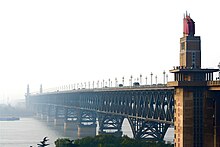  As an important regional hub in the Yangtze River Delta, Nanjing is well-connected by over 60 state and provincial highways to all parts of China. Highways such as Hu–Ning, Ning–He, Ning–Hang enable commuters to travel to Shanghai, Hefei, Hangzhou, and other important cities quickly and conveniently. Inside the city of Nanjing, there are 230 km (140 mi) of highways, with a highway coverage density of 3.38 kilometers per hundred square kilometers (5.44 mi/100 sq mi). The total road coverage density of the city is 112.56 kilometers per hundred square kilometers (181.15 mi/100 sq mi).[132] The two artery roads in Nanjing are Zhongshan Road and Hanzhong Road are also the two main roads which cross each other in the city center, Xinjiekou. Expressways {G+XXxx (National Express, 国家高速), S+XX (省级高速)}:
National Highway Nanjing is a national comprehensive transportation hub, and its highway network density ranks among the top central cities in the country. As of 2019, the total mileage of Nanjing highways opened to traffic has reached 630 kilometers, and the highway network density has reached 9.56 kilometers per 100 square kilometers, ranking first in the country. With Nanjing as the center, Ninghu, Ninggao, Ningzhen, Ningyang, Ningchu, Ninglian, Ningtong, Ningchao, Ninghe, Ningluo, Ningma, Ningxuan, Ningyan, Ninghuai, Ningmu, Ningchang, Ninghang and other high-grade highways lead to Jiang surrounding provinces and cities in a radial pattern. Main long-distance bus terminals: Nanjing Bus Station, Nanjing South Bus Station, Nanjing North Bus Station, Nanjing East Bus Station, Jiangning Bus Station, Lishui Bus Station, Gaochun Bus Station, Nanjing Getang Bus Station. {G1xx (which starts from Beijing), G2xx (north-south), G3xx (west-east)}:
Public transport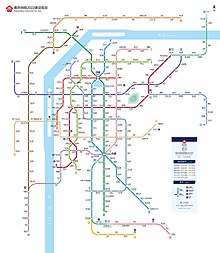 The city has an efficient public transport network, which mainly consists of bus, taxi and metro systems. The bus network, which is currently run by three companies since 2011, provides more than 370 routes covering all parts of the city and suburban areas.[133] At present, the Nanjing Metro system has a grand total of 449 km (279 mi) of route and 208 stations across 12 lines. They are Line 1, Line 2, Line 3, Line 4, Line 7, Line 10, Line S1, Line S3, Line S6, Line S7, Line S8 and Line S9. The city is planning to complete a 17-line Metro and light-rail system by 2030.[134] The expansion of the Metro network will greatly facilitate intracity transport and reduce the currently heavy traffic congestion. Nanjing's first subway officially opened on September 3, 2005. It is the sixth city in mainland China to open a subway. As of 2019, Nanjing subway has 12 lines and 208 stations, with a total length of 449 kilometers and an average daily passenger flow. With more than 3.4 million passengers, the length of subway lines ranks seventh in China and eighth in the world. As of the end of 2018, Nanjing had 6,909 buses, operating 468 bus lines, with a total length of 7,670.9 km (4,766.5 mi), an average daily mileage of 1,178×106 km (732×106 mi), and an average daily passenger volume of 2,182 million. At present, Nanjing has eliminated buses below the National III standard and non-air-conditioned buses, and the number of pure electric buses ranks second in the world. As of the end of 2019, there were more than 12,000 real-name certified taxis in Nanjing. The appearance of the taxis was mostly uniform yellow and black, and the royal blue luxury taxis were a minority. As of July 2019, there are six online ride-hailing platforms in Nanjing, namely Meituan Taxi, Didi Chuxing, First Taxi-hailing, Cao Cao Special Car, Shenzhou Special Car, T3 Travel, and the current car qualification rate of each platform is 70% the above. At present, there are about 13,000 online car-hailing vehicles legally applying for "car permits" in Nanjing. As of 2019, there are two lines of Nanjing trams. Nanjing Hexi Tram was officially put into operation on August 1, 2014. It is the world's first inter-area contactless tram, and China's first tram to be charged at a station. The line is about 7.76 kilometers long and has 13 stations., Including 4 subway transfer stations. The Nanjing Kylin Tram was officially put into operation on October 31, 2017. The line is about 8.95 kilometers long and has 15 stations, including 1 subway transfer station. Culture and art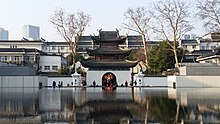 Being one of the four ancient capitals of China, Nanjing has always been a cultural center attracting intellectuals from all over the country. In the Tang and Song dynasties, Nanjing was a place where poets gathered and composed poems reminiscent of its luxurious past; during the Ming and Qing dynasties, the city was the official imperial examination center (Jiangnan Examination Hall) for the Jiangnan region, again acting as a hub where different thoughts and opinions converged and thrived. Today, with a long cultural tradition and strong support from local educational institutions, Nanjing is commonly viewed as a "city of culture" and one of the more pleasant cities to live in China. Art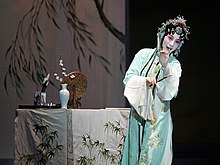 Some of the leading art groups of China are based in Nanjing; they include the Qianxian Dance Company, Nanjing Dance Company, Nanjing Little Red Flower Art Troupe, Jiangsu Peking Opera Institute and Nanjing Xiaohonghua Art Company among others. Jiangsu Art Gallery is the largest gallery in Jiangsu Province, presenting some of the best traditional and contemporary art pieces of China like the historical Master Ho-Kan;[135] many other smaller-scale galleries, such as Red Chamber Art Garden and Jinling Stone Gallery, also have their own special exhibitions. As of 2019, Nanjing has 14 cultural centers, 100 cultural stations, 15 public libraries (excluding libraries for education systems and enterprises and institutions), 132 movie theaters, and 2 large-scale convention and exhibition centers. They are Nanjing International Exhibition Center and Nanjing International Expo Center, 87 various museums, including 77 state-owned museums and 10 non-state-owned museums. As of the end of August 2020, there are 137 calligraphy and painting academies, art museums, and art galleries in Nanjing. Nanjing is an important town of Chinese painting and calligraphy. In the Six Dynasties, there were painting and calligraphy masters such as Wang Xizhi, Wang Xianzhi, Zhang Sengyou, Lu Tanwei, and Gu Kaizhi. The earliest extant painting theory work "Paintings" has a profound impact on later generations. The Nantang Art Academy brought together outstanding calligraphy and painting masters at a time. Dongyuan and Juran pioneered the Southern School of Landscape and became a generation of masters. Xu Xi's flower and bird paintings, Zhou Wenju, and Gu Hongzhong's figure paintings continue to pass. "Han Xizai's Night Banquet" is a masterpiece of ancient Chinese meticulous brushwork. The system of Nantang Painting Academy was also inherited by later generations. The Painting Book of Ten Bamboo Studios in the Ming dynasty reproduced the paintings with the pinnacle of three-dimensional color printing techniques. The Painting Book of Mustard Seed Garden in the early Qing dynasty was regarded as a must-read for learning Chinese painting. The "Eight Masters of Nanjing" headed by Gong Xian were active in Nanjing in the early Qing dynasty and created the Jinling School of Painting. In the 1930s, celebrities in painting circles such as Lv Fengzi, Xu Beihong, Zhang Daqian, Yan Wenliang, Lu Sibai, Chen Zhifo, Gao Jianfu, Pan Yuliang, and Pang Xunqin gathered in Nanjing. Among them, Xu Beihong, Zhang Shuqi, and Liu Zigu were hailed as the "Three Masters of Jinling". Contemporary "New Jinling Painting School" represented by Fu Baoshi, Qian Songyan, Song Wenzhi, Wei Zixi, Yaming, Festivals Many traditional festivals and customs were observed in the old times, which included climbing the City Wall on January 16, bathing in Qing Xi on March 3, hill hiking on September 9 and others (the dates are in Chinese lunar calendar). Almost none of them, however, are still celebrated by modern Nanjingese. Instead, Nanjing, as a tourist destination, hosts a series of government-organized events throughout the year. The annual International Plum Blossom Festival held in Plum Blossom Hill, the largest plum collection in China, attracts thousands of tourists both domestically and internationally. Other events include Nanjing Baima Peach Blossom and Kite Festival, Jiangxin Zhou Fruit Festival and Linggu Temple Sweet Osmanthus Festival. LibrariesNanjing Library, founded in 1907, houses more than 10 million volumes of printed materials and is the third largest library in China, after the National Library in Beijing and Shanghai Library. Other libraries, such as city-owned Jinling Library and various district libraries, also provide considerable amount of information to citizens. Nanjing University Library is the second largest university libraries in China after Peking University Library, and the fifth largest nationwide, especially in the number of precious collections. Museums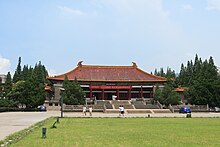 Nanjing has some of the oldest and finest museums in China. Nanjing Museum, formerly known as National Central Museum during ROC period, is the first modern museum and remains as one of the leading museums in China having 400,000 items in its permanent collection.[136] The museum is notable for enormous collections of Ming and Qing imperial porcelain, which is among the largest in the world.[137] Other museums include the City Museum of Nanjing in the Chaotian Palace, the Oriental Metropolitan Museum,[h] the China Modern History Museum in the Presidential Palace, the Nanjing Massacre Memorial Hall, the Taiping Kingdom History Museum, Jiangning Imperial Silk Manufacturing Museum,[i] Nanjing Yunjin Museum, Nanjing City Wall Cultural Museum, Nanjing Customs Museum in Ganxi House,[j] Nanjing Astronomical History Museum, Nanjing Paleontological Museum, Nanjing Geological Museum, Nanjing Riverstones Museum, and other museums and memorials such Zheng He Memorial[k] Jinling Four Modern Calligraphers Memorial.[l] TheaterJiangsu Province Kun Opera is one of the best theaters for Kunqu, China's oldest stage art.[139] It is considered a conservative and traditional troupe. Nanjing also has professional opera troupes for the Yang, Yue (shaoxing), Xi and Jing (Chinese opera varieties) as well as Suzhou pingtan, spoken theater and puppet theater. Most of Nanjing's major theaters are multi-purpose, used as convention halls, cinemas, musical halls and theaters on different occasions. The major theaters include the People's Convention Hall and the Nanjing Arts and Culture Center. The Capital Theater well known in the past is now a museum in theater/film. Xiqu is a traditional Chinese drama. After a long period of development and evolution, it has gradually formed the Chinese Opera Garden with the five major Chinese opera types of "Peking Opera, Yue Opera, Huangmei Opera, Ping Opera, and Henan Opera" as the core. Peking opera has a long history in Nanjing: the famous Peking opera master Mei Baojiu has a deep connection with Nanjing. As the honorary president of the "Nanjing Meilanfang Jingkun Art Research Association", Master Mei Jiubao made a special trip to Nanjing as the "Research Association" "Unveiled, and led his disciples to perform the Meipai famous play" The Return of the Phoenix " Zheng Ziru, the famous Peking opera artist, performed "The Flower Spear" in Nanjing. Kunqu Opera is one of the oldest operas in traditional Chinese opera, and it is also a treasure of traditional Chinese culture and art, especially opera art. It is called an "orchid" in the Hundred Gardens. In Nanjing, famous professional Kunban classes such as "Xinghua Ministry", "Hualin Ministry", "Li Yujia Ban", and "Cao Yinjia Ban" appeared in Nanjing, and the style of singing songs by the voiceless section and literati also continued. Drama is a form of Western drama introduced in the 20th century. In recent years, Nanjing's annual drama box office has continued to rise. The drama "Mrs of the Sea" staged in Nanjing in 2017, "Broken Gold", "Treasure Island Village" in 2018, and "Hamlet" in 2019 have the highest box office in the country. All fell in Nanjing. Not only that, the box office and attendance rate of some plays such as "White Deer Plain" in Nanjing are also far ahead in the Yangtze River Delta region. Quyi is the collective name of the various "rap art" of the Chinese nation. It is a unique art form formed by the long-term development and evolution of folk oral literature and singing art. The local folk arts in Nanjing include Southern Crosstalk, Nanjing Baiju, Nanjing Vernacular, Nanjing Pinghua, Gaochun Yangqiang Mulian Opera, Liuhe Hongshan Opera, etc. Night life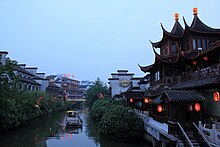 Traditionally Nanjing's nightlife was mostly centered around Nanjing Fuzimiao (Confucius Temple) area along the Qinhuai River, where night markets, restaurants and pubs thrived.[140][141] Boating at night in the river was a main attraction of the city. Thus, one can see the statues of the famous teachers and educators of the past not too far from those of the courtesans who educated the young men in the other arts. In the past 20 years, several commercial streets have been developed, hence the nightlife has become more diverse: there are shopping malls opening late in the Xinjiekou CBD, as well as in and around major residential areas throughout the city. The well-established "Nanjing 1912" district hosts a wide variety of recreational facilities ranging from traditional restaurants and western pubs to dance clubs, in both its downtown location and beside Baijia Lake in Jiangning District. In recent years, many night-life options have opened up in Catherine Park as well as in shopping malls such as IST in Xinjiekou and Kingmo near Baijai Lake metro station. Other, more student-oriented places are to be found near to Nanjing University and Nanjing Normal University. Food The local cuisine in Nanjing is called Jinling cuisine (金陵菜). It is one important part of Jiangsu cuisine (江苏菜). Jinling cuisine is famous for its meticulous process, emphasizing no added preservatives and its seasonality. Its duck and goose dishes are well known among Chinese for centuries. It also employs many different style of cooking methods, such as slow cooking, Chinese oven cooking, etc. Its dishes tend to be light and fresh, suitable for all. Many of the city's local favorite dishes are based on ducks, including Nanjing salted duck, duck blood and vermicelli soup, and duck oil pancake.[142] The flavor snacks of Jinling Tea House have become an integral part of Qinhuai culture. In addition, Jiangning, Liuhe and Gaochun each have their own local flavors. "Suiyuan Food List", "Baimen Recipe", "Yecheng Vegetable Book" are the crystallization of Nanjing food culture. The radish is considered typically representative of the people of Nanjing, an association commonly known throughout China.[143] Nanjing people like to eat wild vegetables during the Qingming Festival, and they named the eight most eaten spring vegetables and wild vegetables as the "Eight Dry Seasons". The phrase "eight fresh sweet-scented osmanthus fragrance" refers to eight kinds of aquatic fruits and vegetables associated with the Mid-Autumn Festival. Sports Nanjing is the birthplace of modern Chinese sports. In 1910, the first National Games in Chinese history was held. In 1924, the predecessor of the Chinese Olympic Committee (All-China Sports Association) was established in Nanjing. China's first Olympic delegation trained, assembled, and set off in Nanjing. Nanjing is the birthplace of China's Olympic dream and one of the cities that contributed the most to China's participation in the Olympics. Nanjing has an irreplaceable position in the history of the Chinese Olympics. Nanjing's planned 20,000 seat Youth Olympic Sports Park Gymnasium will be one of the venues for the 2019 FIBA Basketball World Cup.[144] As a major Chinese city, Nanjing is home to many professional sports teams. 2020 Chinese Super League champions Jiangsu Football Club, owned by Suning Appliance Group, was a tenant of Nanjing Olympic Sports Center from 2007 until the club's dissolution in 2021.[145] Jiangsu Nangang Basketball Club is a competitive team which has long been one of the major clubs fighting for the title in China top-level league, CBA. Jiangsu Volleyball men and women teams are also traditionally considered as at top level in China volleyball league. There are two major sports centers in Nanjing, Wutaishan Sports Center and Nanjing Olympic Sports Center. Both of these two are comprehensive sports centers, including stadium, gymnasium, natatorium, tennis court, etc. Wutaishan Sports Center was established in 1952 and it was one of the oldest and most advanced stadiums in early time of People's Republic of China. Nanjing hosted the 10th National Games of PRC in 2005 and hosted the 2nd summer Youth Olympic Games in 2014.[146][147] 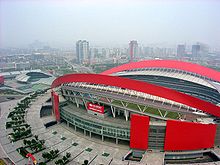 In 2005, to host The 10th National Game of People's Republic of China, there was a new stadium, Nanjing Olympic Sports Center, constructed in Nanjing. Compared to Wutaishan Sports Center, which the major stadium's capacity is 18,500,[148] Nanjing Olympic Sports Center has a more advanced stadium which is big enough to seat 60,000 spectators. Its gymnasium has capacity of 13,000, and natatorium of capacity 3,000. On February 10, 2010, the 122nd IOC session at Vancouver announced Nanjing as the host city for the 2nd Summer Youth Olympic Games. The Nanjing 2014 Youth Olympic Games featured all 28 sports on the Olympic program and were held from August 16 to 28. It is the first time that China has hosted the Youth Olympic Games and the second time that China has hosted an Olympic event. Main venues: Nanjing Olympic Sports Center, Wutaishan Sports Center, Youth Olympic Sports Park, Nanjing Institute of Physical Education (Central Stadium), Nanjing Longjiang Stadium, Nanjing National Fitness Center, Jiangning Sports Center, Lishui Sports Center, Gaochun Sports Center, etc. Main teams: Jiangsu Football Club (dissolved), Nanjing Monkey Kings, Jiangsu Dragons (a.k.a. Jiangsu Nangang), etc. ArchitectureThe city is renowned for its wide variety of architectures which mainly contain buildings from multiple dynasties, the Republic of China, and the present. Inside the walled city
Outside the walled city
SymbolsCity Tree: Cedar City Flower: Prunus mume Tourist city symbol: Long Pan Tiger Standing FolkloreThe main folklore activities in Nanjing include Chinese New Year greetings for the Spring Festival, hanging Spring Festival couplets at the city gate, eating rice cakes, welcoming the God of Wealth on the fifth day of the first lunar month, climbing the city on the 16th day of the first lunar month, sweeping the tomb on Qingming Festival, dragon boat races on the Dragon Boat Festival, eating rice dumplings, and begging for gifts on Qixi Festival, Liqiu gnawing autumn, Mid-Autumn reunion, eating moon cakes, enjoy the moon and go to the melon rack in the field and pick melon beans under the bean shed, Chongyang ascends, Chongyang cake inserted Chongyang flag, Laba food porridge, sent stove on the 24th lunar month, New Year's Eve reunion and ancestor worship. LiteratureThe first "Literature Museum" in Chinese history, the first literary theory and criticism monograph "Wen Xin Diao Long", the earliest existing collection of poetry and essays "Selected Works of Zhaoming", China's first poetic theory and criticism monograph "Shi Pin" ", the first collection of zhiren novel," Shi Shuo Xin Yu, "and the first children's enlightenment book "Thousand Characters "were all born in Nanjing. Masterpieces such as "A Dream of Red Mansions" and "The Scholars" are inseparable from Nanjing. Modern literary giants such as Lu Xun, Ba Jin, Zhu Ziqing, Yu Pingbo, Zhang Henshui, Zhang Ailing have inextricably linked with Nanjing, and the masterpiece "The Earth" by the American writer Pearl Buck who won the Nobel Prize for Literature was created in Nanjing. Famous contemporary literary writers in Nanjing include Su Tong, Bi Feiyu and Ye Zhaoyan. Film and televisionIn 1950, 1,800 projectionists from around the country traveled to Nanjing for a training program.[149]: 71 These projectionists replicated the training program in their own home provinces to develop more projectionists.[149]: 71 Nanjing was later termed a "Cradle of People's Cinema."[149]: 71 Nanjing, as the ancient capital of the Six Dynasties and a famous scenic spot, has become the "best location" favored by directors. Among them, the 93 edition of "Legend of the New White Lady" was shot at Jiming Temple in Nanjing; "Deep Love and Rain" shot at Nanjing Pukou Railway Station; "The Founding of the People's Republic" shot at Sun Yat-sen Mausoleum, Meiling Palace, Southeast University Auditorium, etc. .; and more movies and TV series "Jinling Thirteen Hairpins", "To Our Dying Youth", "Tuina", etc. were all shot in Nanjing. Music and danceJinling Qin School is an important genre of Chinese Guqin art that originated in Nanjing. It has a great influence on many later generations of Qin Schools. It originated from the Royal Music Officials of the Ming dynasty and has been listed as a World Intangible Cultural Heritage Project. The folk song "Jasmine Flower" originated from the "Flower Tune" sung by Liuhe folks for a century, and is world-famous. Xishanqiao folk song performances have repeatedly appeared on CCTV. In addition, there are Gaochun folk songs "Caihongling", "Planting Seedlings in May", Liuhe folk songs "Flower Tune", "Liuzuo Blow Music" etc. In 2016, the Nanjing Forest Music Carnival, sponsored by the Propaganda Department of the Jiangsu Provincial Party Committee and the Nanjing Municipal People's Government, has been held 5 times. Since 2014, Jiangsu Music Broadcasting will hold the Midou Music Festival in Nanjing every year. The 7th Midou Music Festival; and the popular Nanjing University Student Music Festival in recent years. Traditional folk dances in Nanjing include Luoshan Dragon, Dongba Dama Lantern, Sparrow Jump, Jiangpu Hand Lion, Gaochun Dance Wuban, Wanbei Xiaoma Lantern Dance, Qixia Dragon Dance, Changlu Carrying Dragon, Tongshan Gaotai Lion Dance, Dongba Peiqiao stilts, Longyin Che, Zhetang Shahuo, Dangdang, Luohan, Zhuzhen stilts are all intangible cultural heritages. Created by the Nanjing Dancers Association, the original local drama "The Place Closest to Dream", with students from the Department of Music of the School of Aeronautics and Astronautics as the performance team, shows youthful demeanor with the theme of youth entrepreneurship; performed by Nanjing folk performing artists "Drum and Dragon Celebrating the New Year" is a classic of Nanjing folk dance in recent years; the "Nanjing City Intangible Cultural Heritage Scene Demonstration" Jinling Season "hosted by Nanjing Cultural Bureau and undertaken by Nanjing Art Museum is a work of high artistic level. In Nanjing, we have the first professional children's art school in the country that integrates cultural education, art education and stage performances, Nanjing Art Primary School, referred to as Nanjing Xiaohonghua Art Troupe. The school implements small-class education in an all-round way, and promotes both culture and art. It has been rated as a meritorious unit in Nanjing many times, and twice was awarded the honorary title of "National Children's Cultural Work Advanced Group" by the Central Ministry of Culture. PhotographyNanjing has many excellent photography works, as well as large-scale photography exhibitions, photography conferences, etc. Zhao Ran's "Quadette of Enchanting Hair", Ben Daochun's "Tianjiang Cruise", Tian Ming's "Shanghai White-collar Early Class Subway Life", Yu Xianyun's "In the Name of the Country" won 21st, 22nd, 23rd, The 25th National Photographic Art Exhibition Gold Award; Liu Jun's "Fisher Songs and Moon" won the 21st Austria Trembler Super Photo Tour Competition Gold Award; Sun Chonglin's "Little Wangmu" Gold Award in the second PSAChina International Photography Competition. The Nanjing Photographic Association successfully held the third city photography conference in Nanjing; held photography exhibitions such as "World Historical and Cultural Cities", "Hong Kong in the Eyes of Nanjing People", "Nanjing in the Eyes of College Students"; in Italy, Japan, Singapore, and other countries held "Splendid Nanjing" and "Ancient Capital Nanjing" photography exhibitions in Italy, Japan, Singapore, and other countries; held "Harmonious Nanjing", "I Love Nanjing", "Nanjing City Walls", "Four Seasons Jinling" and other photography competitions; edited and published "Nanjing New Look", "Nanjing", "Splendid Nanjing", "Brilliant Nanjing", "Nanjing City Wall" and other large-scale picture albums. In 2022, the photography competition, "A Decade of Nanjing", organised by Nanjing People's Association for Friendship with Foreign Countries (NPAFFC), sought to chart the changes in Nanjing through the eyes of foreigners living in the city. Almost half a million online votes were cast to decide the final winners.[150] Folk craftsThere are many kinds of folk crafts in Nanjing, including brocade, paper-cutting, lantern color, gold leaf, folding fan, velvet flower, carved velvet, wood carving, bamboo carving, etc. As of 2019, Nanjing has 4 world human intangible cultural heritage projects (guqin art, Nanjing cloud brocade weaving, Chinese engraving, and printing techniques, Chinese paper-cutting), 11 national intangible cultural heritage projects, 64 Jiangsu Province and 70 Nanjing City intangible cultural heritage project. EducationBy 2021, Nanjing has 68 institutions of higher learning,[13] including ten 111-plan universities, eight 211 universities, and 97 academicians. As the educational center of southern China for more than 1,700 years, Nanjing has many highly ranked educational institutions,[14] with the number of universities (13) listed in 147 Double First-Class Universities ranking third (after Beijing and Shanghai).[151] The ratio of college students to the total population ranks No.1 among large cities nationwide. Nanjing has the fifth-largest scientific research output of any city in the world.[152] As of 2023, it has been ranked as the world's top second scientific research center in earth & environmental sciences after Beijing and the world's top third scientific research center in chemistry after Beijing and Shanghai, according to the Nature Index.[18][153][154] Nanjing was ranked 80th globally by the QS Best Student City in 2017.[155] Nanjing University is considered one of the top national universities nationwide, and it is ranked among the world's top 20 universities by Nature Index.[16] According to the World Reputation Rankings by the Times Higher Educations, Nanjing University is ranked among the top 100 universities with its best reputation in 2021.[156] Southeast University is also among the most famous universities in China and is considered one of the best universities for Architecture and Engineering in China. Many universities in Nanjing have satellite campuses or have moved their main campus to Xianlin University City in the eastern suburb. Some of the other most prominent national universities in Nanjing are: Some of the other most prominent national universities in Nanjing are:
Private universities and colleges, such as Communication University of China, Nanjing and Hopkins-Nanjing Center are also located in the city.
Some notable high schools in Nanjing are: Jiangpu Senior High School, Jinling High School, Liuhe First School, Nanjing Foreign Language School, The Second Yuying Foreign Languages School of Nanjing, High School Affiliated to Nanjing Normal University, Nanjing No.1 High School, Nanjing Zhonghua High School, Caulfield Grammar School (Nanjing Campus), Nanjing No.29 High School, Yuhuatai Senior High School. Sister cities and twin towns
Nanjing's sister-city relationship with Nagoya, Japan, was suspended on February 21, 2012,[160] following public comments by Nagoya mayor Takashi Kawamura denying the Nanjing Massacre.[161] Non-governmental relations have been subsequently restored.[162] Notable people
See alsoNotes
ReferencesCitations
Sources
External linksWikimedia Commons has media related to Nanjing.
|
|||||||||||||||||||||||||||||||||||||||||||||||||||||||||||||||||||||||||||||||||||||||||||||||||||||||||||||||||||||||||||||||||||||||||||||||||||||||||||||||||||||||||||||||||||||||||||||||||||||||||||||||||||||||||||||||||||||||||||||||||||||||||||||||||||||||||||||||||||||||||||||||||||||||||||||||||||||||||||||||||||||||||||||||||||||||||||||||||||||||||||||||||||||||||||||||||||||||||||||||||||||||||||||||||||||||||||||||||||||||||||||||||||||||||||||||||||||||||||||||||||||||||||||||||||||||||||||||||||||||||||||||||||||||||||||||||||||||||||||||||||||||||||||||||||||||||||||||||||||||||||||||||||||||||||||||||||||||||







